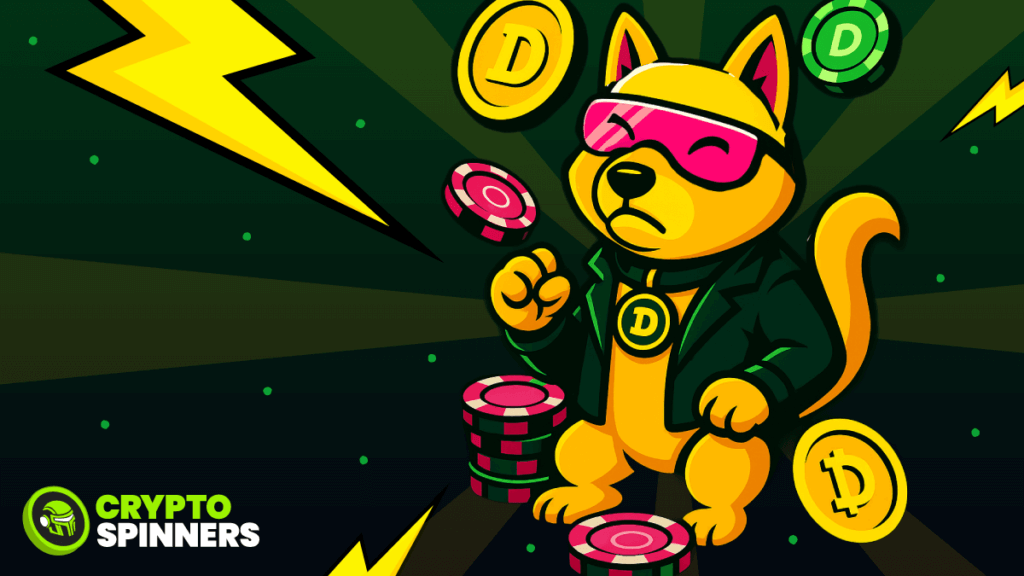Dogecoin Casinos – Tested & Reviewed
Fast and cheap memecoin ⚡From a memecoin to Elon Musk’s endorsement to a widely accepted memecoin, Dogecoin has been through a lot. The coin has definitely evolved as a digital currency with practical use cases. Let’s find out if it’s suitable for gaming online.

Dogecoin’s current market cap is more than $35 billion, which makes it one of the top 10 cryptocurrencies in terms of market cap. Historically, DOGE has reached a peak value of $0.737567 in May 2021 – thanks to Elon Musk’s tweets.
When it comes to casinos, some of the latest reports suggest that Dogecoin holds approximately 2.7% of the crypto gambling market share, which places it among the top 5 coins. Considering the latest figures, it doesn’t come as a surprise that most crypto casinos accept this memecoin.
In this article, we will be looking at some of the top-rated Dogecoin casinos, how to use DOGE at crypto casinos as well as pros and cons of using the memecoin.
| 💡 TL;DR |
|---|
| Dogecoin (DOGE) is a widely accepted memecoin with a large market cap, and it’s supported by most crypto casinos. Compared to Bitcoin and Ethereum, Dogecoin offers faster and cheaper transactions. On an average, Dogecoin transactions take 1 minute to process and the cost is minimal to zero. Our top picks for DOGE casinos are BC.Game, Cryptorino, and Cloudbet. |
Best Dogecoin Casinos – Quick Look
Each of our recommendations here have been reviewed by our team of experts and rated using a standard in-house system. You can check out in-depth reviews on all casinos at CryptoSpinners.
| Category | Casino | Welcome Bonus | Visit Website |
|---|---|---|---|
| Best Dogecoin casino overall | BC.Game | Up to $1,600 + 400 Free Spins | Check T&Cs |
| Best anonymous Dogecoin casino | Cryptorino | 100% match up to 1 BTC | Check T&Cs |
| Best for sports betting | Cloudbet | Up to $2,500 Cash | Check T&Cs |
Please note that these casinos have been handpicked by our team. You can check out more options that accept Dogecoin on our site.
Best Dogecoin Casino Sites – In-Depth Analysis
In this section, we have taken a deep dive into each of the casino sites that we listed above and give you a better idea.
BC.Game
What We Like
- 7,000+ Games
- Lots of promotions
- Offers a native token
Payment methods
Casino features
BC.Game has been in the game for more than 8 years, which in itself, makes it one of the strongest contenders on its list. The platform accepts almost all major cryptocurrencies, including Dogecoin. In fact, it can DOGE transactions almost instantaneously with minimal fees – thanks to its crypto-focused infrastructure. In fact, the platform also has native BCD token system, which functions as a loyalty currency and offers a more gamified crypto experience.
While reviewing BC.Game in-house, we were pleased with two things – games and bonuses. To start with, the casino offers 7,000+ games, which includes their “original” games like Crash and Plinko. And to add value for players, the platform is quite generous with bonuses. For instance, if you sign up, you become eligible for a 4-tiered welcome bonus (which is great because several crypto casinos do not offer a deposit welcome bonus). Plus, if you are a high roller or a regular bettor, you can benefit from the VIP program that offers perks like no-fee withdrawals and exclusive coin drops.
Cryptorino
What We Like
- 6,000+ casino games
- Elaborate sportsbook
- 24/7 live chat support
Payment methods
Casino features
Compared to major players like BC.Game and Gamdom, Cryptorino is fairly new to the crypto gambling scene. However, in a short time, the platform has managed to make a name for itself as a privacy-focused crypto casino (very much like Betpanda). The platform’s no KYC policy is a big plus, if you are a privacy-conscious DOGE user. You can get started right away on the Cryptorino without the hassle of identity verification.
While privacy is definitely the central appeal, there’s that we liked about Cryptorino when we reviewed it. In fact, we were especially pleased with the bonus offerings. Their welcome bonus structure offers 100% matching up to 1 BTC equivalent plus 50 free spins, while the 10% weekly cashback program operates without wagering requirements.
Further, the platform currently offers over 6,000 games, including the staples like slots, crash games, and live casino. At the time of writing, we did not see any “original” titles, but the existing selection is more than sufficient for most players. Interestingly, Cryptorino has a good sportsbook that covers Soccer and DOTA 2 and everything in between, which makes it suitable for casino players who also like to bet on sports.
Cloudbet
What We Like
- Generous welcome bonus
- Fast, unlimited withdrawals
- Exclusive player experience
Payment methods
Casino features
Speaking of sports betting with crypto, I don’t think it gets any better than Cloudbet. This platform has more than a decade of experience under its belt, and it’s one of the pioneers of crypto casinos. Over the years, the site has started accepting a wider variety of cryptocurrencies, including Dogecoin. The platform’s architecture handles Dogecoin transactions with institutional-grade efficiency, supporting deposits from 0.00015 DOGE and processing withdrawals typically within minutes.
For sports bettors, the platform covers everything from major sports leagues to esports and virtual sports, with competitive odds and high betting limits up to 12 BTC equivalent. Their live betting interface with real-time statistics provides serious sports bettors the data needed for informed wagering decisions. To add to that, Cloudbet offers an early cash-out feature, which gives you more strategic flexibility. To top it all off, promotional offerings like weekly reload bonuses maintain ongoing value.
What is Dogecoin and How to Use it for Casinos?
As mentioned earlier in the guide, Dogecoin is widely accepted as the first ever “memecoin” – a cryptocurrency that’s meant to be a joke. It was created by Billy Markus and Jackson Palmer, two software engineers, and released in December 2013.
The coin was meant to be a satirical take on Bitcoin. However, Dogecoin quickly went viral, especially on Reddit, and within two weeks of launching had reached a market cap of $8 million.
Over the years, Dogecoin has developed a lot. Some of the major upgrades include the relaunch of the Dogecoin Foundation in 2021, which encourages long-term development and community involvement. Then, in 2022, the core 1.14.x update enhanced UI, security, network efficiency, and fee restructuring.
More recently, in 2025, Project Sakura was started, which is currently exploring a transition to a hybrid proof-of-stake (PoS)/proof-of-work (PoW) consensus to boost transaction speeds, scalability, and more.
“Dogecoin benefits from an active community, and most of its value comes from there. This is something that not a lot of cryptocurrencies can achieve. However, it’s a double-edged sword, as the hype may die down and affect the coin’s value.”
Nitisha U., Crypto Content Strategist
Coming to Dogecoin’s usage in crypto casinos and betting, the coin is widely accepted in the industry. Plus, it offers benefits that major coins like Bitcoin cannot, like wider accessibility, smaller deposits, faster transactions, and lower costs.
Dogecoin Deposits and Withdrawals at Casinos
If you want to use Dogecoin at an online crypto casino, first you’ll need to acquire some. This means, you have to head over to a reputable exchange (like Kraken or Binance), buy some DOGE, and then look for a trusted crypto casino.
Deposit
Assuming that you have found a reliable crypto casino that supports Dogecoin, you now have to fund your account. Before you deposit anything, check out the minimum and maximum deposit thresholds. We have already covered in detail how you can make a deposit at crypto casinos.
The process usually involves heading over to the deposit section, selecting Dogecoin as your currency, double-checking the wallet address, and making the transfer via your wallet. As Dogecoin transactions are fast, the deposit amount should be reflected in under a minute.
Withdrawals
When you’re ready to cash out, all you have to do is simply transfer the amount from the casino’s wallet to your own wallet.
Please note that this is just a general rundown of how DOGE payments would work at a crypto casino. The exact process may vary from one platform to another. In case of any difficulties, do not hesitate to reach out to the casino’s support team.
| 💡 Fun fact: Dogecoin has an inflationary supply |
|---|
| It means there is no maximum cap on the total number of DOGE coins, and new coins are continually created and added to circulation. Unlike deflationary cryptocurrencies such as Bitcoin, which have a hard supply cap, Dogecoin releases a set number of new tokens each year, which stabilizes the inflation rate over time. |
Pros & Cons of Dogecoin for Casinos
Now that we are familiar with what Dogecoin is and how to use it at casinos, let’s weigh the pros and cons.
✅ Pros
- As we saw, most crypto casino platforms accept Dogecoin, so you should be able to choose from a wide variety.
- As Dogecoin was built on Litecoin’s code base and uses Scrypto algorithm, it can process transactions faster than Bitcoin. In fact, most transactions are processed in under a minute.
- Unlike Bitcoin, Dogecoin charges minimal to almost zero fees. If you are a small stakes bettor, this will save you a lot of funds in the long run.
- Crypto casinos’ minimum deposits vary depending on the coin. With DOGE, these thresholds are usually lower, which makes it suitable for small transactions.
- Dogecoin has a vocal, devoted user base that supports online adoption, charitable campaigns, fundraising, and viral visibility.
❌ Cons
- Most cryptocurrencies (excluding stablecoins) are inherently volatile. However, as DOGE’s value derives from popularity and community support, rather than underlying utility or technology, it is especially susceptible to unpredictable swings and pump-and-dump cycles.
- Beyond tipping, micro-payments and crypto casinos, Dogecoin lacks advanced features like smart contracts or robust DeFi functionality, constraining real-world adoption.
- Unlimited DOGE production can dilute long-term value if demand doesn’t keep pace with new supply, discouraging long-term holding.
Final Thoughts
To sum up, Dogecoin is fairly widely accepted across crypto casinos and betting sites, so there’s a lot you can choose from. With Dogecoin, you get faster and cheaper transactions, which is especially beneficial for small stakes betting and frequent withdrawals. The only thing you need to watch out for is the DOGE’s value. For this guide, we have handpicked three crypto casinos – BC.Game, Cloudbet, and Cryptorino. However, there are several other options that you can explore if none of them meet your needs.




